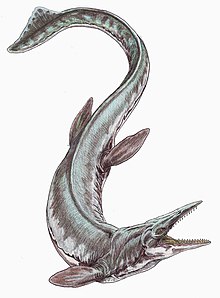海王龙亚科
| 海王龙亚科 化石时期:
| |
|---|---|

| |
| 海王龙 | |
| 科学分类 | |
| 界: | 动物界 Animalia |
| 门: | 脊索动物门 Chordata |
| 纲: | 爬行纲 Reptilia |
| 目: | 有鳞目 Squamata |
| 总科: | †沧龙总科 Mosasauroidea |
| 科: | †沧龙科 Mosasauridae |
| 亚科: | †海王龙亚科 Tylosaurinae Williston, 1895[1] |
| 属 | |
海王龙亚科(Tylosaurinae)是沧龙科的其中一个亚科,是群多样化的海生有鳞目动物,生活于白垩纪晚期[1][2]。
海王龙亚科是最大的沧龙类,海王龙与海诺龙的身长为9-15米,海诺龙甚至可以达到17米以上,为当时最大的海洋生物之一。它们的骨骼有许多空洞,里面充满脂肪组织以增加浮力,显示它们是敏捷的掠食者。
Russell在1967年将海王龙亚科定义为拥有以下特征:前上颌骨牙齿前方有大型喙、上颌骨与齿骨拥有12颗或以上的牙齿、后耳骨有个供的第5到7根脑神经经过的孔、基枕骨或基蝶骨没有供基底动脉通过的管道、方骨的蹬上突大,而且末端尖、上隅骨背侧边缘圆,而且成水平、荐前椎有29颗、后部尾椎的神经棘稍长,但并没有形成明显的鳍、脉弓并未固定至尾髓、四肢并没有形成平顺的表面。海王龙的荐前椎总长度短于荐后椎的总长度[3]。

海王龙亚科的各属被发现于各大陆,除了澳洲与南美洲。海王龙亚科通常是大型海生蜥蜴,拥有坚固的牙齿,撞击用的吻突是由延长的前上颌骨与齿骨所构成。在南达科他州发现的一个海王龙类化石,拥有胃部内容物化石,包含其他沧龙类、硬骨鱼、大型海鸟黄昏鸟、可能还有鲨鱼,显示海王龙类的食物来源广泛[4]。一个由查尔斯·斯腾伯格(Charles Sternberg)发现的标本[5],体内包含小型的蛇颈龙类骨头[6]。
在1992年,Lingham与Soliar提出海王龙亚科并非沧龙科中游泳速度最快的,也并非最强壮的[7]。海王龙亚科的体格为轻型,身体重量大量减少,并拥有相当小的胸带、骨盆带、以及四肢。它们的骨头为高度多孔结构,可能充满了脂肪细胞,可增加浮力。这些特征显示海王龙亚科可能是伏击掠食者。海王龙亚科是最大型的沧龙类之一,海王龙与海诺龙的某些种身长可达9到15米,使它们成为最大型的海生爬行动物之一。罗素在1967年叙述的T. zangerli[3],原本是海王龙的一个小型种,但现在被认为是一个未成年的T. proriger个体[8]。在2005年,Everhart建立堪萨斯海王龙,化石发现于斯莫基希尔河白垩层[9]。
Polcyn与Bell在2005年建立了一个更大的演化支,称为罗赛尔龙类科(Rullessosaurina)[10],包含:海王龙亚科与扁掌龙亚科、以及它们的姐妹分类单元(包含特提斯龙、罗塞尔龙、亚瓜拉龙)。
海王龙亚科首次出现在化石记录是在康尼亚克阶,并存活到马斯特里赫特阶,大约存活了2000万年[11]。
参考资料[编辑]
- ^ 1.0 1.1 Williston, S. W. 1895. New or little-known extinct vertebrates. Kansas University Quarterly 6:95-98.
- ^ Williston, S. W. 1897. Range and distribution of the mosasaurs with remarks on synonymy. Kansas University Quarterly 4(4):177-185.
- ^ 3.0 3.1 Russell DA, 1967. Systematics and morphology of American mosasaurs. Peabody Museum of Natural History, Yale University, Bulletin 23.
- ^ Martin JE, Bjork PR. 1987. Gastric residues associated with a mosasaur from the late Cretaceous (Campanian) Pierre Shale in South Dakota. Dakoterra 3:68-72.
- ^ Sternberg CH. 1922. Explorations of the Permian of Texas and the chalk of Kansas, 1918. Kansas Academy of Science, Transactions 30(1):119-120. (Papers - Fifty-first annual meeting, 1919), State Printer, Topeka.
- ^ Everhart MJ. 2004. Plesiosaurs as the food of mosasaurs; new data on the stomach contents of a Tylosaurus proriger (Squamata; Mosasauridae) from the Niobrara Formation of western Kansas. The Mosasaur 7:41-46.
- ^ Lingham-Soliar T. 1992. The tylosaurine mosasaurs (Reptilia, Mosasauridae) from the upper Cretaceous of Europe and Africa. Bulletin de L’Institut Royal des Sciences Naturelles de Belgique. Sciences de la Terre 62:171-194.
- ^ Kiernan CR, 2002. Stratigraphic distribution and habitat segregation of mosasaurs in the Upper Cretaceous of western and central Alabama, with an historical review of Alabama mosasaur discoveries. Journal of Vertebrate Paleontology 22(1):91-103.
- ^ Everhart MJ. 2005a. Tylosaurus kansasensis, a new species of tylosaurine (Squamata: Mosasauridae) from the Niobrara Chalk of western Kansas, U.S.A. Netherlands Journal of Geosciences / Geologie en Mijnbouw 84 (3): 231-240.
- ^ Polcyn MJ, Bell GL Jr. 2005. Russellosaurus coheni n. gen., n. sp., a 92 million-year-old mosasaur from Texas (USA), and the definition of the parafamily Russellosaurina. Netherlands Journal of Geosciences 84(3): 321-333.
- ^ Everhart MJ. 2005b. Earliest record of the genus Tylosaurus (Squamata; Mosasauridae) from the Fort Hays Limestone (Lower Coniacian) of western Kansas. Transactions 108 (3/4): 149-155.
- Bell, G. L. Jr., 1997. A phylogenetic revision of North American and Adriatic Mosasauroidea. pp. 293–332 In Callaway J. M. and E. L Nicholls, (eds.), Ancient Marine Reptiles, Academic Press, 501 pp.
- Lindgren, J. et. Siverson, M. 2002.Tylosaurus ivoensis: a giant mosasaur from the early Campanian of Sweden. Royal Society of Edinburgh Transactions: Earth Sciences Vol. 93(1):73-93.
- Russell, D. A. 1970. The vertebrate fauna of the Selma Formation of Alabama, Part VII, The mosasaurs, Fieldiana, Geology Memoirs 3(7):369-380.
| |||||||||||||||||||||||||||||||||||||||||||||||||||||||||||||||||||||||||||||||||||||||||||||||||||||||||||||||||||||||||||||||||||||||||
|


